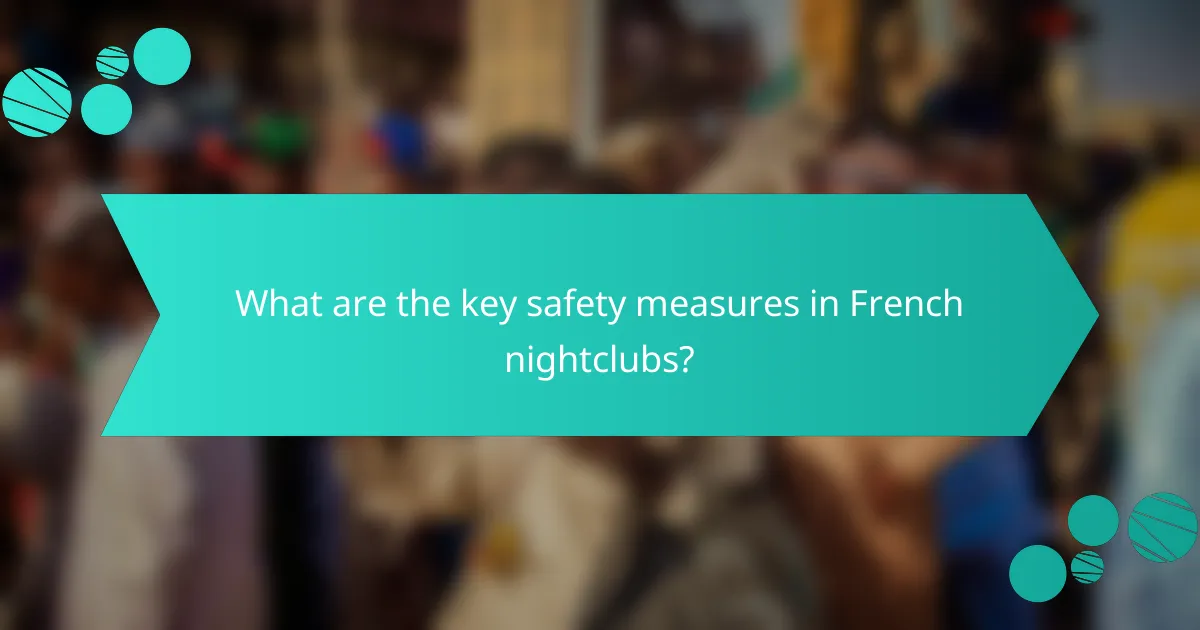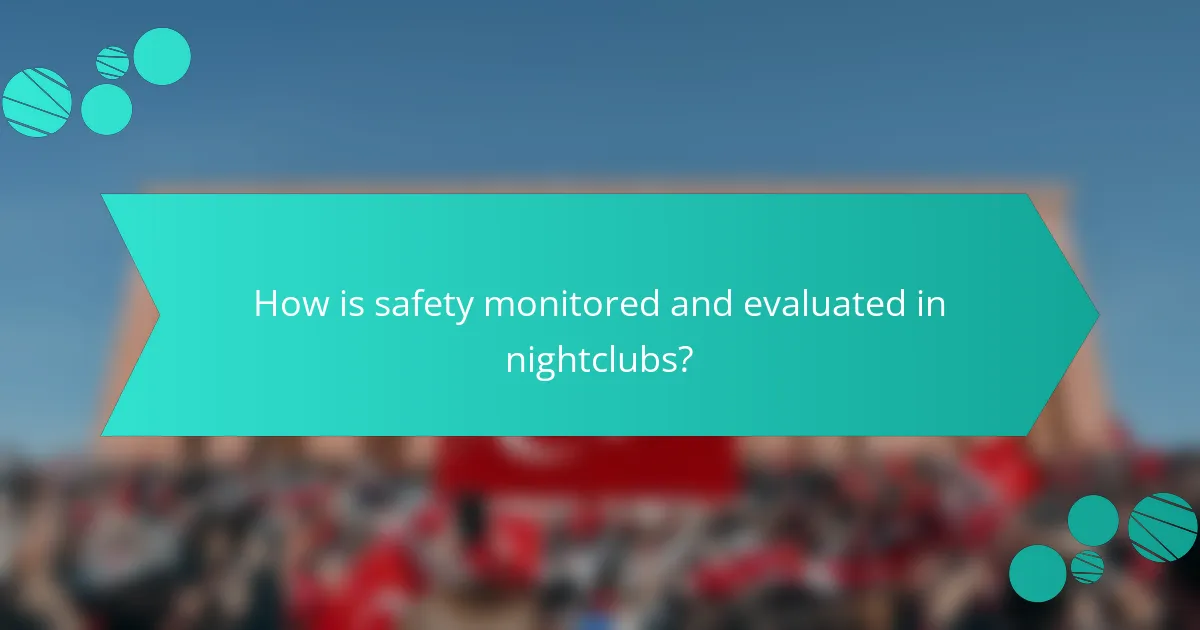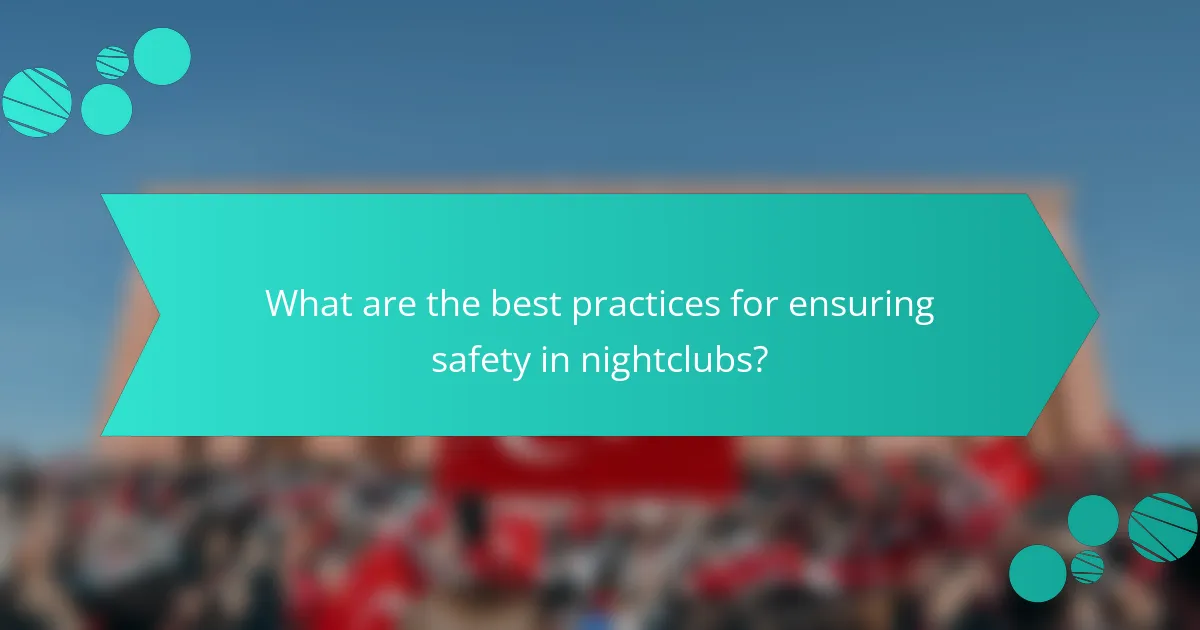Safety measures in French nightclubs encompass a range of protocols designed to protect patrons and ensure a secure environment. Key components include stringent entry checks for ID verification, advanced surveillance systems to monitor activities, and trained security personnel for crowd management and incident response. Emergency exit routes are clearly marked for quick evacuation, while responsible alcohol service policies aim to prevent overconsumption. Regular safety audits and staff training on emergency procedures further enhance the effectiveness of these measures, creating a safer and more enjoyable nightlife experience for all guests.

What are the key safety measures in French nightclubs?
Key safety measures in French nightclubs include strict entry checks, surveillance systems, and trained security personnel. Entry checks often involve ID verification to prevent underage access. Surveillance systems, such as CCTV, monitor the venue for any suspicious activity. Trained security personnel are present to manage crowd control and respond to incidents. Additionally, emergency exit routes are clearly marked to ensure quick evacuation if necessary. Many nightclubs also implement responsible alcohol service policies to minimize overconsumption. These measures collectively enhance the safety and security of patrons while maintaining a fun environment.
How do security protocols enhance safety in nightclubs?
Security protocols enhance safety in nightclubs by establishing structured measures to prevent incidents. These protocols include comprehensive staff training on emergency response and conflict resolution. Surveillance systems monitor activities, deterring potential criminal behavior. Access control measures ensure that only authorized individuals enter the premises. Regular safety drills prepare staff for emergency situations, improving response times. Incident reporting procedures allow for quick documentation and analysis of any issues. According to the National Institute of Justice, effective security protocols can reduce crime rates in nightlife venues by up to 30%.
What specific security measures are commonly implemented?
Commonly implemented security measures in French nightclubs include ID checks, bag searches, and CCTV surveillance. ID checks ensure that guests are of legal age. Bag searches help prevent prohibited items from entering the venue. CCTV surveillance monitors activities for safety and incident response. Additionally, trained security personnel are present to manage crowd control. Emergency exit plans are established to ensure safe evacuations. These measures are designed to enhance safety and security for all patrons.
How do security personnel manage crowd control effectively?
Security personnel manage crowd control effectively by implementing strategic planning and communication. They assess crowd size and behavior to determine necessary resources. Personnel are trained to identify potential issues before they escalate. They utilize clear signage and barriers to guide crowd movement. Communication devices facilitate coordination among team members. Regular training ensures preparedness for various scenarios. Historical data shows that proactive measures reduce incidents significantly. For instance, events with well-planned crowd management report 30% fewer altercations.
What guest policies are in place to ensure safety?
French nightclubs implement several guest policies to ensure safety. These policies include age verification to prevent underage entry. Clubs often require valid identification for age checks. Bag checks are conducted at the entrance to prevent prohibited items. Security personnel monitor the venue to manage crowd control. Emergency exits are clearly marked and accessible for quick evacuation. Many clubs enforce a zero-tolerance policy for violence and harassment. These measures are designed to create a safe environment for all guests. Compliance with local laws further reinforces these safety protocols.
What identification requirements do nightclubs enforce?
Nightclubs enforce strict identification requirements to verify the age and identity of patrons. Typically, a government-issued photo ID is required. Acceptable forms include passports, national identity cards, or driver’s licenses. These IDs must be valid and not expired. Some nightclubs may also require a secondary form of identification. This ensures compliance with local laws regarding alcohol consumption. Nightclubs implement these measures to maintain safety and security within their premises. Failure to present valid identification often results in denial of entry.
How do dress codes contribute to a safer environment?
Dress codes contribute to a safer environment by promoting uniformity and reducing the likelihood of gang-related activities. A clear dress code helps staff identify individuals who do not adhere to the established guidelines. This identification can deter potential troublemakers from entering the venue. Additionally, specific attire can minimize the risk of concealed weapons. For example, clothing that is too baggy may hide dangerous items, while a strict dress code can prevent this. Furthermore, dress codes can foster a sense of community and belonging among patrons. This can lead to more responsible behavior and a decrease in conflicts. Overall, the enforcement of dress codes is a proactive measure to enhance safety in nightlife settings.
What emergency procedures are established in French nightclubs?
French nightclubs have established emergency procedures to ensure guest safety. These procedures include regular staff training on emergency response protocols. Staff are trained to manage evacuations effectively during emergencies. Nightclubs also conduct regular safety drills to prepare for various scenarios. Emergency exits are clearly marked and accessible to patrons. First aid kits and trained personnel are available on-site. In case of fire or violence, security personnel are instructed to alert local authorities promptly. These measures align with French safety regulations for public venues.
What steps are taken in case of a fire or medical emergency?
In case of a fire or medical emergency, immediate evacuation is the first step. Patrons are instructed to follow the nearest exit signs. Staff members are trained to assist in guiding guests to safety. Fire alarms are activated to alert everyone in the venue. Emergency services are contacted promptly for medical assistance or fire response. First aid kits are available for minor injuries. Designated staff members may provide first aid if necessary. Regular drills ensure that staff are prepared for emergencies.
How do nightclubs communicate emergency protocols to guests?
Nightclubs communicate emergency protocols to guests through multiple methods. They often display emergency exit signs prominently throughout the venue. Staff members are trained to guide guests during emergencies. Nightclubs may also conduct safety briefings at the beginning of events. Some venues utilize digital screens to relay emergency information. Announcements over the sound system can inform guests of urgent situations. Additionally, emergency protocols may be included in promotional materials or on the nightclub’s website. These methods ensure that guests are aware of safety measures and can respond appropriately in emergencies.

How is safety monitored and evaluated in nightclubs?
Safety in nightclubs is monitored and evaluated through various security protocols and procedures. Security personnel conduct regular patrols within the venue to identify potential risks. Surveillance cameras are installed to monitor guest behavior and detect any unusual activity. Emergency exits are clearly marked and accessible to ensure quick evacuation if necessary. Staff is trained to handle emergencies, including medical incidents and crowd control. Incident reports are documented to analyze patterns and improve safety measures. Regular safety audits are performed to assess compliance with local regulations. Feedback from guests is also collected to identify areas for improvement. These measures collectively enhance the overall safety of nightclub environments.
What role do surveillance systems play in nightclub safety?
Surveillance systems play a critical role in nightclub safety. They help monitor and record activities within the venue. These systems deter criminal behavior by increasing the perceived risk of detection. Surveillance footage can assist in identifying suspects during incidents. It also aids in resolving disputes by providing objective evidence. According to a study by the University of Cambridge, venues with surveillance systems report lower crime rates. Additionally, surveillance helps staff respond quickly to emergencies. Overall, these systems enhance the overall security framework of nightclubs.
How do CCTV cameras contribute to incident prevention?
CCTV cameras contribute to incident prevention by providing continuous surveillance in monitored areas. They deter potential criminal activity through visible presence. The presence of cameras can lead to a reduction in theft and vandalism. Studies indicate that areas with CCTV systems experience a decrease in crime rates by up to 51%. Furthermore, recorded footage assists in identifying suspects after incidents occur. This evidence can be crucial for law enforcement investigations. Additionally, real-time monitoring enables security personnel to respond quickly to suspicious behavior. Overall, CCTV cameras enhance the safety and security of environments like nightclubs.
What are the limitations of surveillance systems in nightclubs?
Surveillance systems in nightclubs have several limitations. They often struggle with low visibility in dim lighting conditions. This can hinder the identification of individuals and events. Additionally, camera placement may create blind spots. These blind spots can allow incidents to occur unnoticed. Privacy concerns also limit the extent of monitoring. Patrons may feel uncomfortable under constant surveillance. Furthermore, reliance on technology can lead to complacency among staff. Human oversight is crucial for effective security management. Lastly, the cost of advanced surveillance systems can be prohibitive for some venues. This limits their ability to implement comprehensive security measures.
How do staff training programs enhance safety protocols?
Staff training programs enhance safety protocols by equipping employees with essential skills and knowledge. These programs focus on emergency response, hazard recognition, and proper communication techniques. Employees learn to identify potential risks and respond effectively to incidents. Training also fosters a culture of safety awareness among staff. This proactive approach minimizes accidents and improves overall safety outcomes. Research indicates that establishments with comprehensive training reduce incident rates by up to 50%. Regular training updates ensure staff remain informed about the latest safety standards and practices.
What topics are covered in security training for nightclub staff?
Security training for nightclub staff covers various essential topics. These include conflict resolution techniques to manage disputes effectively. Staff learn to identify and respond to potential threats or suspicious behavior. Training also emphasizes crowd management strategies to ensure safety during peak hours. Emergency response procedures are vital, preparing staff for medical emergencies or evacuations. Additionally, staff receive instruction on legal responsibilities and liabilities in security situations. Alcohol management training is included to prevent over-serving and maintain a safe environment. Finally, communication skills are developed to enhance teamwork and coordination during incidents.
How often are training sessions conducted to ensure staff readiness?
Training sessions are conducted biannually to ensure staff readiness. This frequency allows staff to stay updated on safety protocols and emergency procedures. Regular training helps reinforce knowledge and skills necessary for effective response. Additionally, it ensures compliance with local regulations and standards in the nightclub industry. Studies indicate that ongoing training significantly improves staff performance during emergencies. This structured approach enhances overall safety for guests and employees alike.

What are the best practices for ensuring safety in nightclubs?
Implementing effective safety measures is crucial for nightclubs. Establishing a clear security plan is essential. This includes hiring trained security personnel to monitor the venue. Installing surveillance cameras enhances visibility and deterrence. Conducting regular staff training on emergency procedures is vital. Encouraging a zero-tolerance policy for violence and harassment promotes a safer environment. Implementing ID checks prevents underage drinking and ensures responsible alcohol service. Maintaining well-lit areas reduces the risk of accidents and crime. Regularly reviewing safety protocols keeps the nightclub prepared for potential incidents. These practices contribute to a safer nightclub experience for all patrons.
How can guests contribute to a safer nightclub experience?
Guests can contribute to a safer nightclub experience by being aware of their surroundings. They should report suspicious behavior or potential threats to staff immediately. Guests must also follow the nightclub’s rules and regulations. This includes adhering to capacity limits and respecting designated areas. Staying with friends can enhance personal safety. It is important for guests to avoid excessive alcohol consumption. Keeping personal belongings secure can prevent theft and loss. Lastly, knowing emergency exits and procedures can help in case of an incident. These actions collectively promote a safer environment for everyone.
What are some personal safety tips for nightclub patrons?
Stay aware of your surroundings at all times. Nightclubs can be crowded and chaotic. Avoid excessive alcohol consumption to maintain clear judgment. Always keep your drink in sight to prevent tampering. Use the buddy system and stay close to friends. If you feel uncomfortable, seek help from security personnel. Know the emergency exits and procedures of the venue. Trust your instincts; leave if something feels off. These tips can enhance personal safety in nightlife environments.
How can guests report safety concerns effectively?
Guests can report safety concerns effectively by contacting nightclub security immediately. They should approach a visible security personnel or use designated communication devices. Providing clear and specific information about the concern is crucial. Guests should describe the location and nature of the issue. If the concern involves potential harm, guests should remain calm and prioritize their safety. Nightclubs often have protocols in place for urgent situations. Following these procedures ensures that concerns are addressed promptly and efficiently.
What are common challenges in maintaining safety in nightclubs?
Common challenges in maintaining safety in nightclubs include overcrowding, substance abuse, and violence. Overcrowding can lead to emergencies and hinder evacuation efforts. Substance abuse increases the likelihood of altercations and medical emergencies. Violence can arise from disputes among patrons or gang-related activities. Additionally, inadequate staff training can result in poor response to incidents. Limited surveillance and security presence may fail to deter criminal behavior. Compliance with safety regulations can also be challenging due to varying local laws. These factors contribute to a complex environment for ensuring safety in nightclubs.
How do nightlife trends affect security measures?
Nightlife trends significantly influence security measures in venues. As trends evolve, security protocols adapt to address new risks. For instance, the rise of social media has increased the visibility of nightlife events. This visibility can lead to larger crowds, necessitating enhanced crowd control measures. Additionally, trends such as themed events or live performances may attract diverse audiences. This diversity requires tailored security strategies to manage varying behaviors and expectations. Data shows that venues experiencing increased incidents often revise their security protocols. In 2022, a survey indicated that 70% of nightclub owners adjusted security measures in response to nightlife trends. Thus, the dynamic nature of nightlife directly impacts the effectiveness and implementation of security measures.
What can be done to address issues of violence or harassment?
Implementing comprehensive training programs for staff can effectively address issues of violence or harassment. These programs should focus on recognizing signs of distress and appropriate intervention techniques. Establishing clear reporting procedures is essential for victims to feel safe when coming forward. Regularly reviewing and updating security protocols can enhance the overall safety environment. Encouraging a culture of respect and inclusivity among guests can further mitigate potential conflicts. Utilizing surveillance technology aids in monitoring and responding to incidents swiftly. Collaborating with local law enforcement can strengthen safety measures and provide additional resources. Lastly, conducting regular safety audits ensures that all policies are effective and relevant.
What practical tips can enhance safety in French nightclubs?
To enhance safety in French nightclubs, patrons should stay aware of their surroundings. Avoid accepting drinks from strangers to prevent potential tampering. Use the buddy system by attending with friends and keeping an eye on each other. Choose well-lit areas to walk through when entering or exiting the venue. Familiarize yourself with emergency exits and procedures upon arrival. Limit alcohol consumption to maintain clear judgment. Report any suspicious behavior to staff immediately. These practices contribute to a safer nightlife experience.
Safety measures in French nightclubs encompass various security protocols, guest policies, and emergency procedures designed to ensure patron safety. Key elements include strict entry checks, surveillance systems, trained security personnel, and clearly marked emergency exits. The article details how effective security protocols, such as staff training and crowd management strategies, enhance safety and reduce incidents. It also discusses the role of surveillance systems, identification requirements, and the importance of guest awareness in maintaining a secure nightlife environment. Additionally, practical tips for patrons and common challenges faced in nightclub safety are addressed.